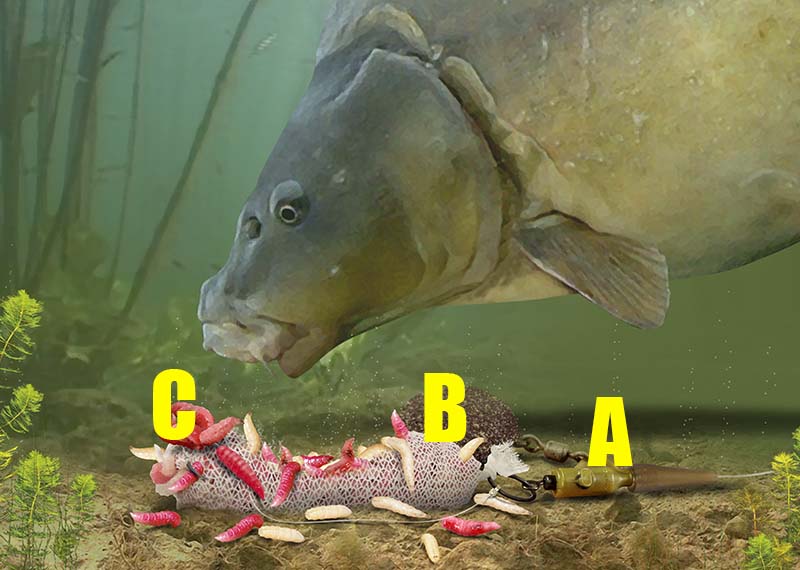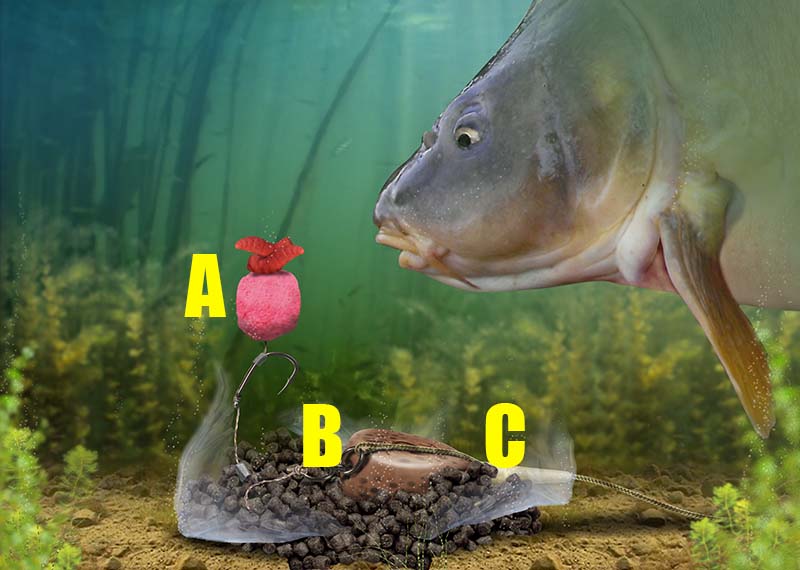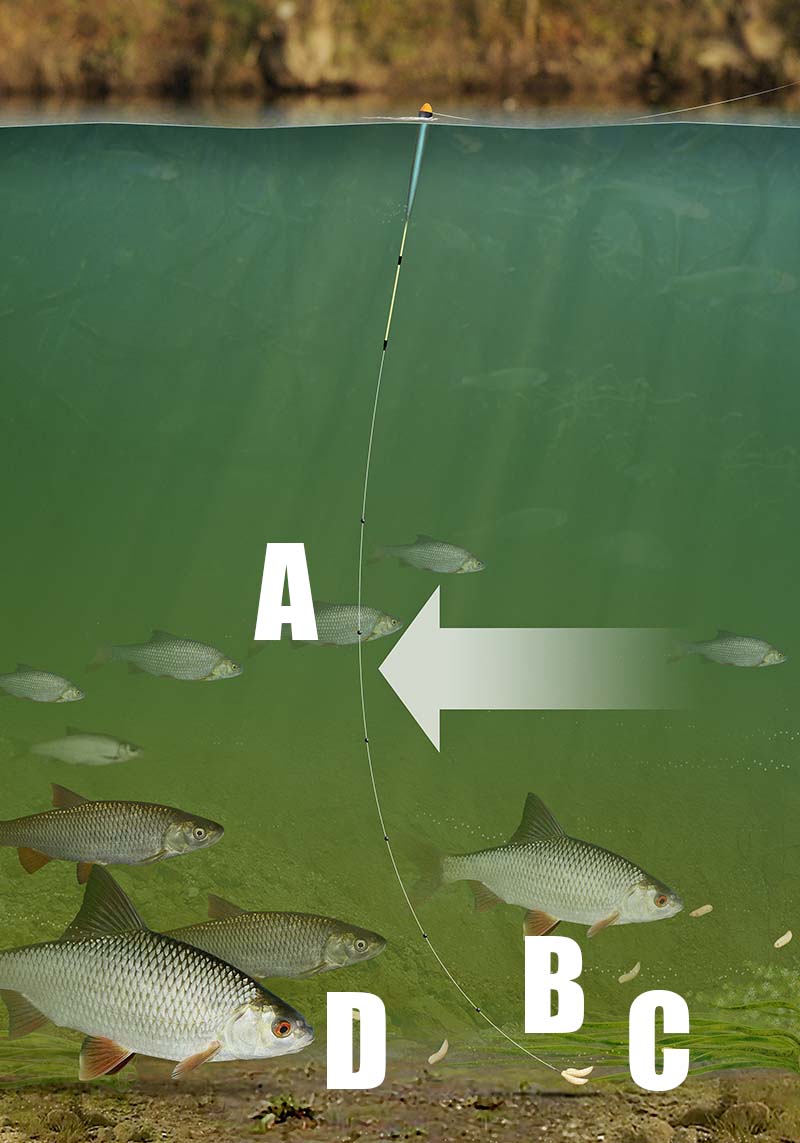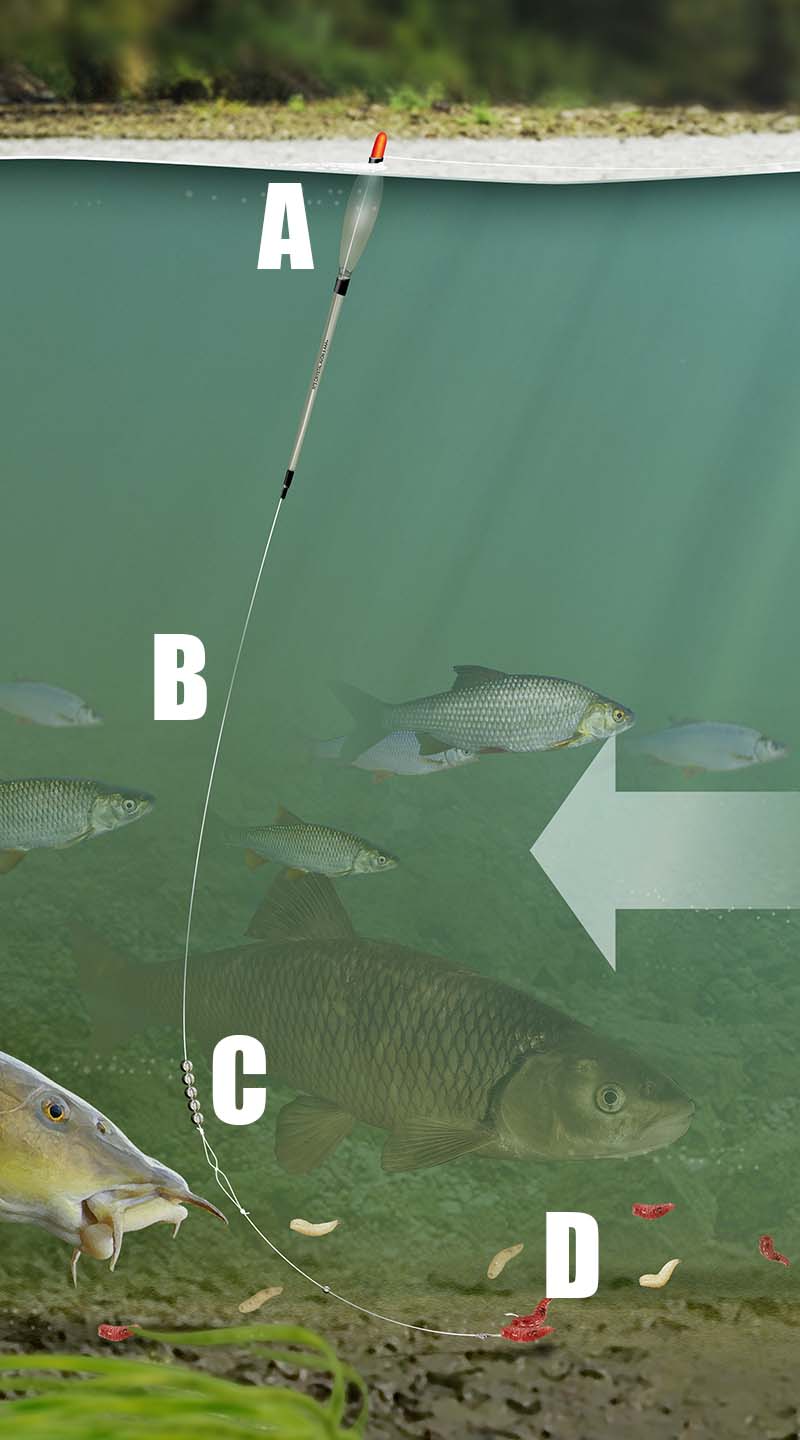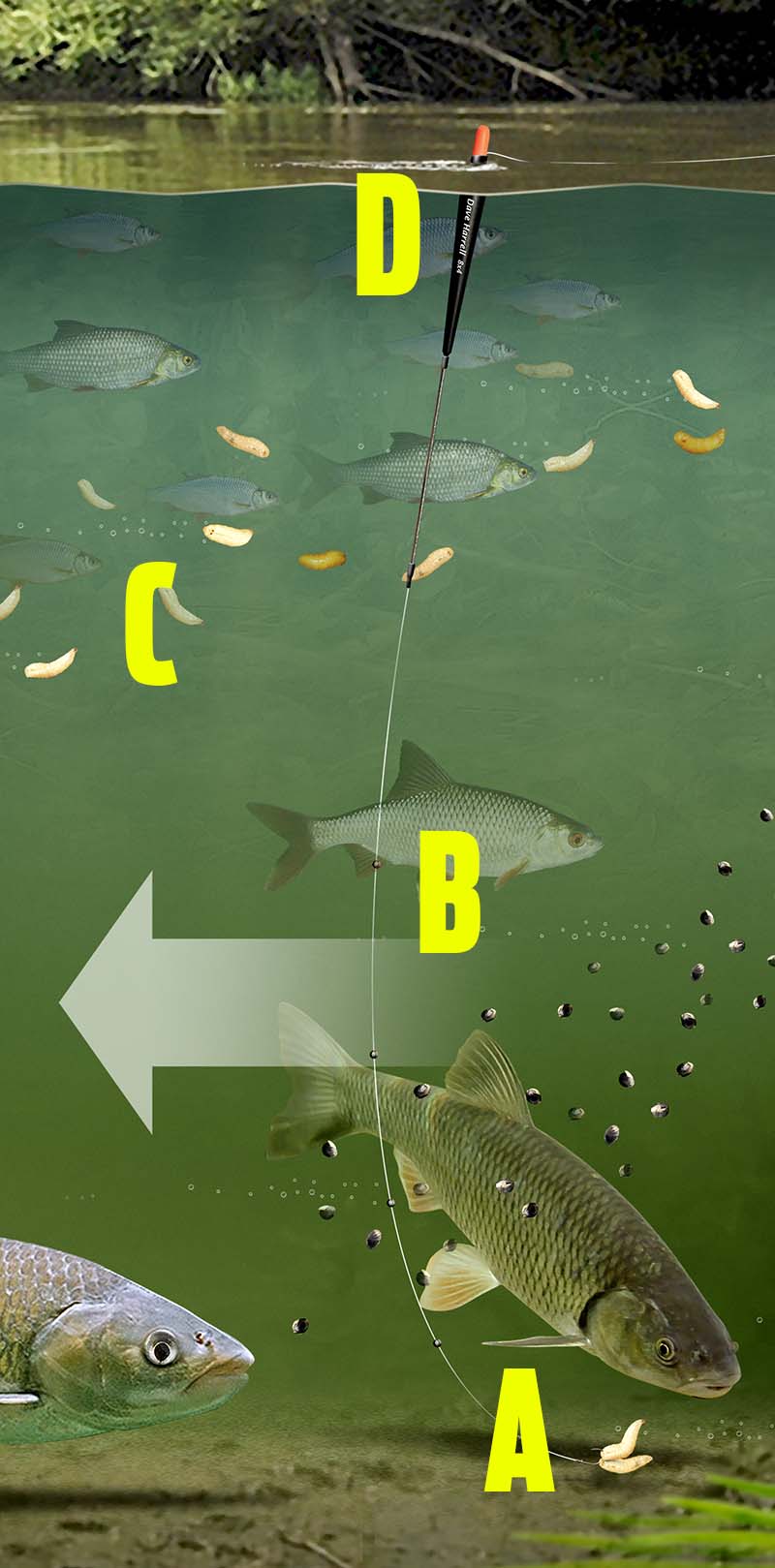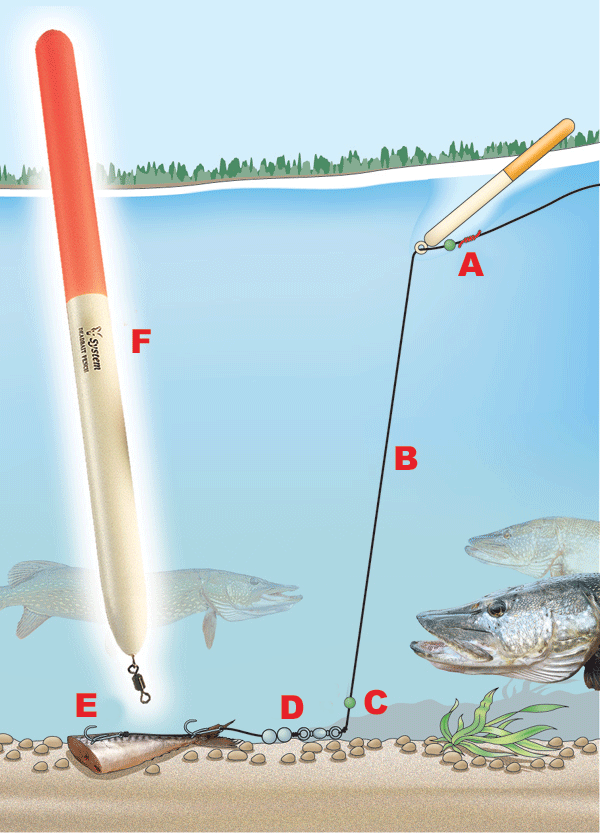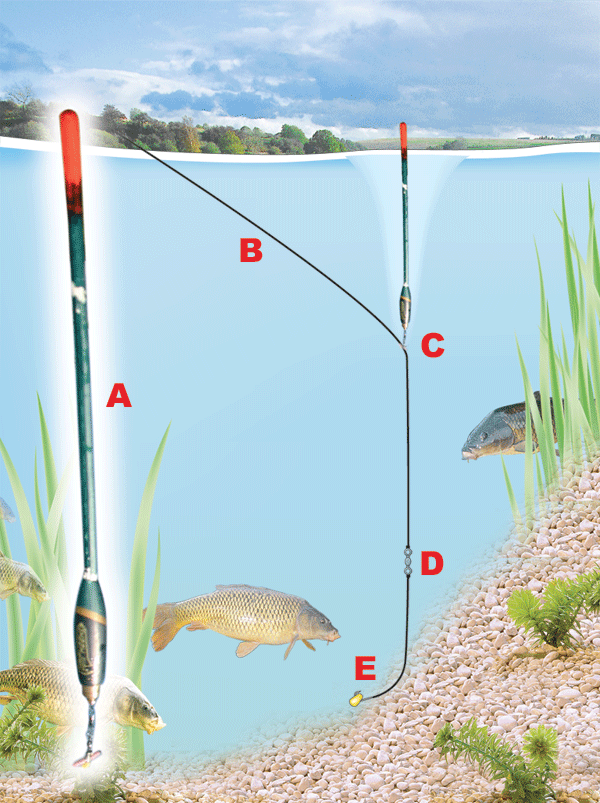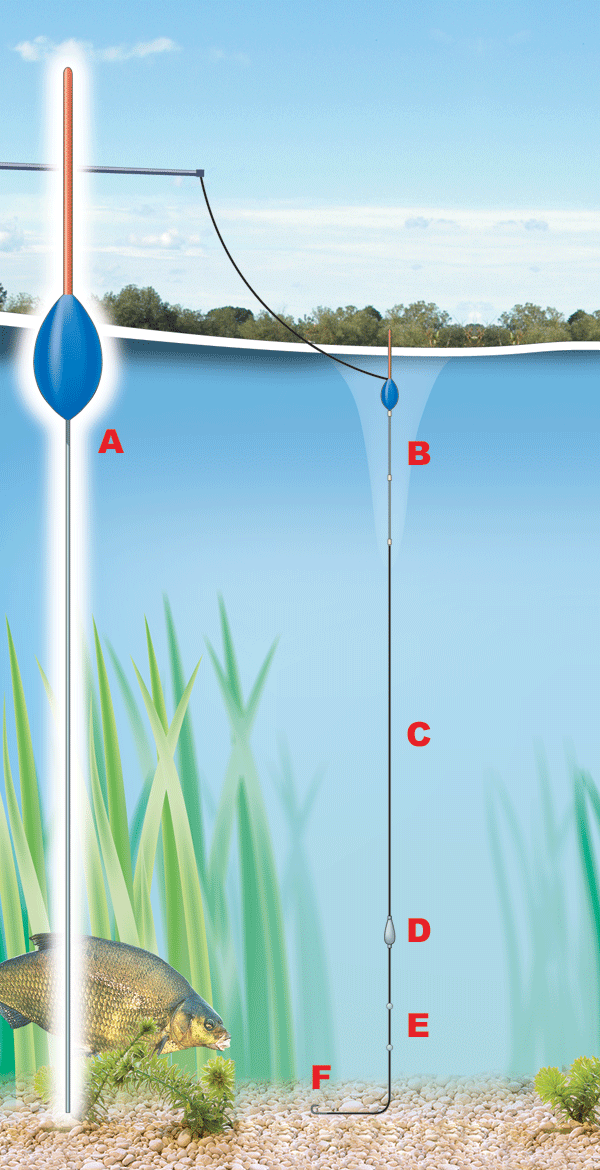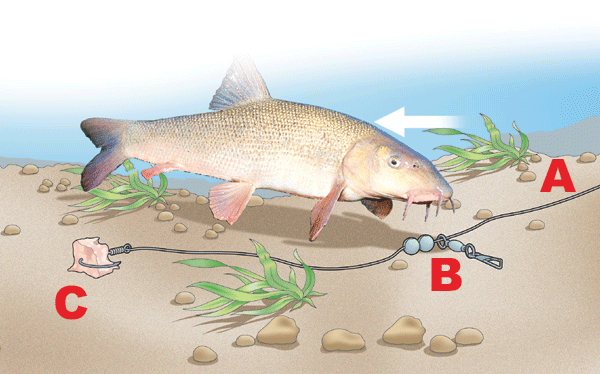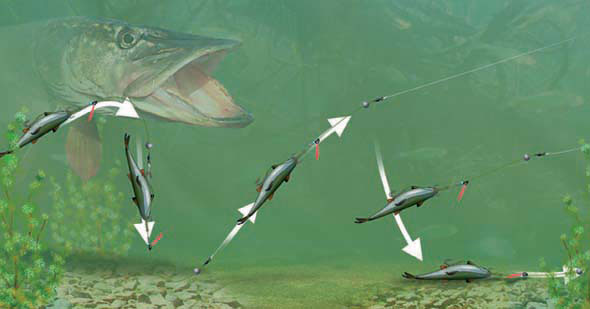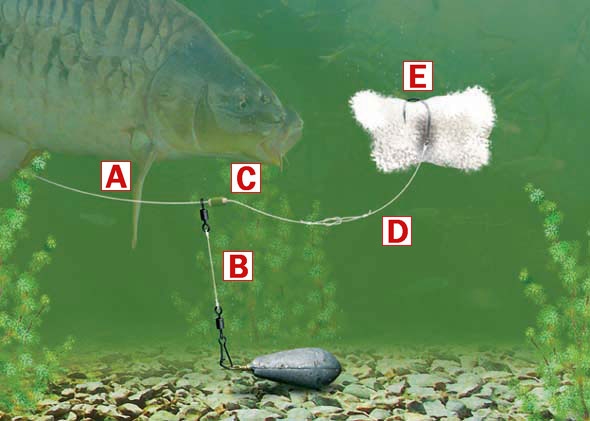How to tie the snowman rig
If you can’t decide whether to use a bottom bait or a pop-up rig, then why not try a snowman instead... it’s the best of both worlds!
In essence, it’s a standard boilie threaded on to a hair rig, with a smaller pop-up threaded on after it. Once on the bottom, the pop-up stands proud, acting like a beacon to any passing carp. Such a bait arrangement allows you to mix and match your baits. For example, you could use a dull, fishy-flavoured bottom boilie, with a bright, fruity pop-up.
Snowman rigs are highly versatile and can be used with any lead set-up, and with just about any length or type of hooklink.
How to tie
Strip back about 6ins of the outer layer from the coated braid. Form a small overhand loop in the end.
Secure a small metal rig ring loosely in place with an overhand knot, just below the hair loop.
Set the rig ring about 1.5ins from end of the loop, then secure firmly with a second granny knot.
Position the rig ring opposite the hook’s barb, then attach the hook using a knotless knot.
At this point you can add a hook aligner over the eye of the hook. This will help with hook-ups.
Finally, add a few small ‘mouse droppings’ of tungsten putty to the hooklink to nail it to the deck.
Top five lures for perch fishing with Sam Edmonds
After the pike, perch and zander have spawned they will be ready to go on a feeding spree. so here are my top five lures that i use when going after perch and zander in spring.
Shad (Berkley Ripple Shad 5cm and 7cm)
The Ripple Shad has a thick paddle tail, and ribs running along the body, which produce lots of vibration when the lure is retrieved – ideal for fishing in coloured canals.
Plastic worm (Berkley Floating Mice Tail)
A plastic worm that works well on a drop shot rig, nose-hooked on a size 6-8 hook. Brown is a great all-round colour, but brighter pink and white lures are great in coloured water.
Crankbait (Berkley Frenzy Flicker Shad Suspending 5cm)
This crankbait dives to around 5ft, great for fishing shallow canals. It covers lots of water quickly, searching out fish, and an internal rattle adds to the enticing action.
Shad (Berkley Powerbait Shrug Minnow 1.5ins)
Rigged on a 1.5g or 2.5g jighead, I use this tiny shad for smaller perch and zander, but it works for big fish too. Orange Glow is a great colour but Cherry Red is a close second.
Twitchtail (Berkley Twitchtail Minnow)
Available in many colours, this is my favourite soft bait for rigging on a drop shot rig to target big perch, but is also great for zander. I like to nose-hook these on a size 2 Owner Mosquito drop shot hook.
How to tie the method feeder rig
Method feeders are a staple among match anglers and, with a few tweaks, can also be used to target big carp, tench and bream.
The only changes you need to make to turn it into a rig capable of landing any carp that swims are to strengthen the component parts and increase the size of the hookbait and loosefeed.
The Method is perfect for ‘runs waters’ or for targeting carp in pressured venues that have seen it all when it comes to rigs.
How to tie the hooklink
Tie on a curved shank hook. We’ve used a palomar knot here, but a grinner is also fine to use.
Thread a micro rig swivelover the point and down the shank, followed by a small hook bead.
Position the hook bead and then attach the bait to the swivel using bait floss or a small bait band.
Tie a swivel to the other end. Make sure it is a snug fit in the base of the frame of the Method feeder.
How to load the method feeder
Put your chosen ingredients into a bait tub. Dampen the comtents and make sure they bind together well.
Place your hookbait in the fat end of the supplied mould and bury it with your Method mix.
Firmly press the feeder into the mould, with the hooklink positioned as shown above.
Remove the frame from the mould. Some frames have push-button releases. You’re ready to cast out!
The adjustable zig rig
As the temperatures begin to rise this clever set-up will enable you to change the depth of your hookbait and search the water column for carp
Carp can spend much of their time up in the water column, especially in spring when the surface layers are warmed by the strengthening sun.
You could fish the margins or on top of gravel bars to present a bottom bait at the same depth as the carp, but in deeper venues a zig rig that presents a buoyant bait in mid-water can be much better. While this tactic is most often used on prolific venues, it has also accounted for some very large carp in recent years.
The adjustable zig not only works in any depth of water, but enables the height of the bait to be instantly adjusted, simply by retrieving or releasing line to reset the float height. The float also creates a bolt-effect, making bites easier to hit with fewer opportunities missed. You can also use the float to quickly gauge the depth of the swim. Try starting with the zig bait at half depth. If this produces no bites, then let the bait rise closer to the surface until you find the carp.
How to tie
Tie a size 10 Nash Fang Gaper hook to a one-metre length of 10lb Zig Line using a simple ten-turn knotless knot
Thread a Zig Aligner on to the hook so that the banded section sits opposite the point of the hook like this
Stretch the band on the Zig Aligner and insert zig foam. Place the black foam on the bottom so it’s easier for carp to see it from below
Tie a Ring Swivel to the other end of the hooklength using a twice-through-the-eye, four-turn grinner knot
Thread the metal ring and Zig Float on to the mainline. The metal ring ensures that the float will rise even when fished in weed
Tie the Ring Swivel to the end of the mainline using a four-turn grinner knot and pull into the hole on the top of the Zig Float
The safe bolt rig
Semi-fixed bolt rigs have become common in modern angling techniques, not just for those targeting carp, but for anglers chasing many other species too.
When a fish moves off with the hookbait, with the lead semi-fixed in place, it soon comes up against the full resistance of the weight and either hooks itself or bolts away giving unmissable bites.
Although originally developed for carp fishing, the rig is just as useful for tench and bream in stillwaters, and barbel and chub in rivers. Various baits can be used, from boilies and pellets to worms and maggots. The key, though, is to ensure that the hookpoint is exposed so that there is the greatest chance of it pricking the fish.
In the event of a line breakage, it is essential that the lead should be able to slide free from the rest of the rig to avoid tethering a fish that has been hooked. To do this, a lead safety clip should be used with the tail rubber lightly pushed on to the clip so that the lead can come free with the minimum of effort. Follow these simple steps below and you will create the perfect safe bolt rig set-up.
Thread a tail rubber and safety lead clip on to your mainline. Ensure it will slide off easily
Tie a rig swivel to the end of the mainline using a four-turn grinner knot or palomar knot
Pull the lead clip over the swivel and use the supplied pin to hold the clip on to the swivel
Attach the lead to the clip and lightly push on the tail rubber. Test that the lead ejects easily
Attach your hook using a knotless knot. The hooklink should be weaker than the mainline
Tie the end of the hooklength to the rig swivel using a four-turn grinner knot
Tench feeder rig
When going after tench there are many tactics that can be used, for instance when you are on a larger gravel pit it is a feeder approach that often scores. This is thanks to its characteristic of placing bait close to the hookbait even when fishing towards distant gravel bars and other features.
While the feeder is brilliant for tench, it often has to be rigged-up with a short hooklength stopped close to the feeder to prove successful for tench. This is because tench tend to sift through food and detritus while hardly moving. Use a long hooklength and the hookbait is likely to be expelled before a bite is registered!
Maggots, casters and worms are all brilliant tench baits because they mimic the fish’s natural diet, and this rig can be used with all three of these baits. To make the hookbait stand out, it pays to pop-up the bait. This can be easily achieved using a slither of rig foam attached to the hair, with the bait fished on the hook. Follow the steps below to learn how to tie this brilliant rig...
Tie a size 10 forged hook to a short length of 8lb fluorocarbon using a knotless knot and attach a slither of red rig foam to the hair
At the other end of the hooklength attach a mini swivel using a four-turn grinner knot. The hooklength should be around 4in long
Slide a medium-sized Clinger on to the mainline, followed by the hooklength swivel and then another Clinger
Slide a mini rig sleeve on to the mainline and then tie on a medium-sized Oval feeder
Adjust the Clingers so the hooklength is fixed just above the feeder
The solid PVA bag rig
As presentations go, solid PVA bags offer a number of advantages that few other set-ups can rival.
Firstly, because the rig is safely packed inside the bag, they can be fished over pretty much any lakebed type and you can be confident your hookbait will be presented effectively. There’s no need to worry about the hook becoming masked by any weed or detritus as it falls through the water. This makes it perfect for casting towards showing fish when you’re unsure of what the lakebed is like.
A short hooklink in conjunction with an inline lead offers unrivalled hooking potential as fish come into contact with the weight of the lead much quicker. Cast out on it’s own, this set-up could easily bury into silt but, as it’s placed inside the bag, this isn’t a problem.
Tying up a few bags prior to your session means you can have all three rods fishing in no time at all and, once the bag melts, you’re left with an irresistible mouthful of bait around your hookbait.
How to make a solid PVA bag
Step 1)
Start by placing a small quantity of your mix in the bag followed by your hookbait. Then add more bait, followed by the lead and then top up with yet more bait mix.
Step 2)
Ensure contents are tightly packed and twist the open end around the lead’s tail rubber
Step 3)
You can carefully lick the twisted section or use PVA tape to keep it all sealed in place
Step 4)
Once the top is sealed, push in the corners at the base of the bag
Step 5)
Moisten the folds and then press them down to create a neat aerodynamic bag for casting.
How to tie: A supple braid hookline for solid PVA bags
Step 1)
Take a short length of supple braid and attach to a curved shank hook using a knotless knot
Step 2)
Trim the tag end of the knotless knot and then slide a small rig swivel on to the hook
Step 3)
This needs to be followed by a small rubber hook bead to trap the swivel in place
Step 4)
Cut a 1cm length of shrink tubing and push it down over the eye of the hook, and steam.
Step 5)
Attach the hookbait by threading it on to a doubled length of fluorocarbon, then blobbing
Step 6)
This is what the finished rig should look like. Its hooking potential in unrivalled.
How to Hair rig worms!
This subtle but clever variation on the typical hair rig enables you to fish more effectively with soft baits such as worms
Legering with worms, especially the more delicate lobworms, can be tricky if you need to fish at range with a heavy weight. Sometimes the worm can be smashed off the hook as it hits the water, or the worm may wriggle free or even mask the point.
All of these problems can severely reduce your catches, so a solution that holds the bait better and lessens the risk of bites being missed is important, especially for specialist anglers.
Normal hair rigs are great at hooking fish, but with soft baits, such as worms, they are less effective as often the bait is lost. This led to this variation on the normal hair rig which incorporates two small discs of foam to cushion the bait on the cast. A Quick Stop is used instead of a normal boilie stop, so there is no chance of the stop being lost when a worm tries to wriggle free.
Another advantage is that this rig works just as well with barbless hooks, as you are not reliant upon the barb to hold the bait in place. This makes it ideal for many commercial fisheries. So, if you are intending to leger worms for carp, tench, bream or perch then give this rig a try to see how effective it can be.
how to tie
Step 1)
Attach a Quick Stop to the end of a length of 6lb hooklength using a simple overhand knot
Step 2)
Leaving a hair of about 15mm, tie on a size 10 hook using a 10-turn knotless knot
Step 3)
Tie a size 10 ring swivel to the other end of the hooklength, which should be 20cm long
Step 4)
Use a lead clip and tail rubber to attach a 1.5oz swivel lead to the mainline
Step 5)
Tie hooklength swivel to mainline using a four-turn grinner knot, then pull lead clip over the swivel
Step 6)
Cut two 2mm thick slithers of rig foam. The round foam sticks give the neatest finish
Step 7)
Thread a small disc of rig foam on to the hair using a Quick Stop needle, followed by a lobworm and then a second small piece of foam
How to tie the ronnie rig!
Gardner tackle's Lewis Rhead walks us through the rig of the moment and how to tie it...
There are rigs and then there is the "Ronnie rig". Some rigs stand the test of time and work year after year. Others are more transient in nature, their tangible benefits are the figment of a twisted mind, and they don’t offer any real advantage in terms of catching carp or being easy to tie!
This one, however, is very special. It’s a rig that’s been used successfully on the quiet for a few years now, being deployed as a tool pivotal in catching some phenomenal big carp from a number of waters. But now the word is out and everyone want's to know how to tie this amazing rig
The Ronnie rig is easy to tie and offers the benefits of a super-consistent low pop-up presentation, fished the height of a hook and a swivel of off the lakebed, but without the issues of a naked hook eye that has the potential to snag in landing-net meshes (one of the main problems associated with the original 360-style rigs).
It offers all the advantages and awesome rig mechanics of the hinged stiff rig, but without the need to trying to fish it low to the lakebed, which isn’t the optimum arrangement. When it’s tied right, those of us that have used it extensively have pure unadulterated confidence in it because hook-pulls are almost non-existent. I can’t remember pulling out of a single fish with the Ronnie rig.
Luckily, it’s amazingly simple to construct thanks to the use of a size 12 Covert Kwik-Lok Flexi Ring Swivel mounted on the eye of the hook. That, combined with a Gardner Mugga hook, offers a highly aggressive, fast-reacting presentation that is ruthless in the extreme!
It’s also extremely versatile. I always have a number of pre-prepared hook sections ready to go, and I tailor the hooklink material to suit the lakebed or the lead arrangement.
That could mean a lead clip with a long, supple, skinned hooklink such as Ultra Skin in silt, or a helicopter-style arrangement and a Subterfuge fluorocarbon boom on clean sand and gravel.
Personally, I think balancing it like a hinged stiff rig works best – so the hookbait is slow to sink. Why? If you overbalance the hook by moulding putty around the shrink tube, the hook has a tendency to lie over further and this inhibits it from twisting and turning as quickly as it could (the same drawback you get with a hinged stiff rig).
Realistically, mounting the swivel through the eye means you need to use a ‘nice’ sized hook, and the size 4 Mugga or Continental Mugga are both perfect. You know, some rigs work with some hooks better than others, and this is the one. The Mugga’s curved swept shank and 20-degree inturned eye complement and enhance the mechanics, lining up the shrink tube naturally in a way that gives maximum ‘twistiness’.
Variants of some rigs come and go, but the Ronnie rig is one that I know will stand the test of time. Like all presentations, it isn’t the panacea of all things riggy, but what it is is the best low pop-up rig that I have used.
Now it's time to show you how to tie this amazing rig so you can go out and use it for yourself!
How to tie
Step 1)
Start by cutting a 1cm length of large Covert shrink tubing.
Step 2)
You then position the shrink tubing on the hook shank.
Step 3)
Attach the hook to a size 12 Kwik Lok Flexi Ring swivel.
Step 4)
The crook will distort slightly as it is opened up.
Step 5)
So once the hook eye is in place squeeze the crook closed with pliers.
Step 6)
Now bring the shrink tubing back down the hook to this position.
Step 7)
Carefully shrink the tubing down using the steam from a kettle.
Step 8)
Now you can slide a size 20 Target Swivel on to the hook.
Step 9)
Follow this with a hook stop to keep the swivel in place
Step 10)
Position the hook stop opposite the barb as shown here.
Step 11)
Attach your pop-up hookbait with some bait floss.
Step 12)
Mould some tungsten putty around the shrink tube to balance the bait.
How to tie the pop-up boilie maggot rig!
Maggots are a superb bait in early spring and are my ‘go to’ tactic when times get hard. The key in is to use a maximum amount of attraction and minimal food. I see a lot of anglers using bucketfuls of maggots, but I really don’t think you need that many.
At this time of year, if you can find the fish you only need a small amount of bait to tempt a bite. Multiple catches can be made using small PVA bags of maggots.
I like to customise my maggots a little, in order to maximise their pulling power. Normally I apply a splash of liquid additive to them the night before, my favourite being L-Zero 30-T, which is naturally very salty and fishy. The maggots take on the flavour of the liquid and by the morning will be oozing with extra attraction.
When I’m buying maggots in the tackle shop, I always ask for them to be sieved. With no maize meal or sawdust, they will sweat up quickly, and so to prevent this I add some Krill Active Mix or powder. Krill works brilliantly with maggots and they will again take on the flavour of the powdered additive.
I use the ‘boosted’ maggots in a PVA bag and add some crumbed Krill boilies too. I hook the bag on to my rig to add all that taste, smell and the small amount of food around the hookbait.
On the rig, I like to use a 12mm Signature pop-up fished just off the bottom. Then, I tie five maggots to the hair loop of the hooklink using a length of bait floss (see sequence, below). I find that five is enough to catch the carp’s eye, but not too many to affect the buoyancy of the pop-up, which would change the way the rig is sitting.
This is fished with a simple combi-rig, with the supple section coming near the hook. This allows the pop-up to sit just off the lakebed, anchored down by a blob of putty. Adopting these tactics has helped me catch some special fish over the last few years. Last autumn, I had a number of carp to over 41lb using this approach - at a time when the lake hadn’t been fishing well and the carp had been hard to catch!
How to tie
Step 1.
Start off by pouring a generous helping of Sticky Baits’ L-Zero 30-T over the maggots
Step 2.
Next, add a small amount of Krill Active Mix to prevent the maggots from sweating too much
Step 3.
The maggots should now look like this. They will be packed full of fishy attraction
Step 4.
Choose a 12mm pop-up boilie in whichever colour you fancy. Yellow and white work well
Step 5.
Use a baiting needle to thread the pop-up on to the hair loop of your hooklink, as normal
Step 6.
Next, using a pair of sharp braid scissors, cut off a 30cm length of bait floss
Step 7
Take a sewing needle and thread on five maggots, nicking them only very lightly
Step 8.
Thread one end of the bait floss through the eye of the sewing needle
Step 9.
Carefully push the maggots on to the bait floss, making sure you don’t burst any of them
Step 10.
Pass the floss through the hair’s loop and secure with a couple of overhand knots
Tommy Pickering | How to make my simple groundbait feeder rig!
This is my favourite set-up for all my open end feeder fishing. It’s a very simple rig for wire cage and plastic frames, and the stiff boom which is tied in the end of the mainline means tangles are kept to a minimum.
As it’s free running it’s completely safe, too. Use it for bream, tench, roach, perch and even carp. All you need is your reel line, your feeder with a swivel eye or snap link attached, a packet of No8 Preston Stotz weights and your chosen hooklength.
Try this simple and tangle-free feeder set up.
Step 1.
Take the mainline or shockleader between thumb and first finger of both hands and twist in opposite directions to twizzle it together.
Step 2.
Ensure that the length of the twizzled line is longer than that of the feeder and link, to stop the two tangling when you cast the finished rig.
Step 3.
Bring the twisted line back over itself to form an overhand loop knot. Pass the end through itself twice and pull to tighten the knot properly.
Step 4.
You’re now left with a twisted section of line of around 6ins long, called a boom. Trim the tag end to reduce line spin when reeling in.
Step 5.
Now slide the swivel eye of the snap link attached to your feeder on to the twisted line and over the knot of the stiff boom.
Step 6.
Attach two No8 Stotz to the mainline just above the twisted section, with the feeder above. These butt against the knot and stop the feeder too.
Step 7.
Time to add your hooklength, which you will probably have already tied. Push the hooklength loop over the end of the twisted boom.
Step 8.
Put the hook itself through the end loop in the twisted boom. Then pull the whole hooklength through with it as it goes through.
Step 9.
The loop-to-loop forms like this - you may need to flick the hooklength over its own loop knot to achieve this perfect connection. Pull tight.
How to tie the Carolina Rig
A: The action of the nose cone hitting against the glass bead on the retrieve makes a tapping noise which can induce a take
B: The leader section enables the lure to flutter to the lakebed under its own weight, which can encourage more bites
C: Because the hook point sits flush to the back of the lure, it is impossible for it to snag up in weed
When faced with a weedy river swim this lure set-up is almost impossible to snag up and is great for big perch....
Originally developed by bass anglers in the USA, the Carolina Rig has proven just as deadly for perch on this side of the Atlantic.
Designed to fish a soft plastic ‘creature’ bait close to the bottom and among thick weed, the Carolina rig has the great advantage that it is almost snagless.
This is because of the special wide gape offset hook that is used, and which are now available from several specialist lure outlets in the UK.
With the hook sitting flush with the top of the bait, this rig can be fished amid plants and sticks with little chance of snagging.
The Carolina rig is fished with a slow lift- and-drop retrieve that enables the soft plastic bait to wiggle enticingly as it moves forward and then flutter weightlessly down as the retrieve is paused. This action is very effective for perch and can also be used for zander too.
While drop shotting is rightfully very popular, other tactics such as the Carolina rig are great alternatives and well worth adding to your repertoire.
HOW TO TIE IT
1. Cut off a 24-inch length of 8lb fluorocarbon line to make the hooklength. Hold on to both ends and pull to straighten the line
2. Tie on the offset hook using a four-turn grinner knot. With fluorocarbon, only one pass through the eye of the hook is required
3. Tie a mini swivel to the other end of the hooklength using a four-turn grinner knot. Wet with saliva before pulling tight
4. Slide a 10g-15g bullet weight on to the mainline braid and follow with an 8mm glass bead. Tie braid to the swivel with a four-turn grinner
5. Thread the hook through the head of your creature bait and then back through the body so that the hookpoint lays flat against the back
6. A striking fish pushes the hook through the bait exposing the hookpoint, yet the lure will glide effortlessly through snags and weed
How to fish the lift method for carp, tench and bream
This technique is brilliant for tackling the margins. It was made famous by John Wilson, who has used it extensively for carp on many of Britain's lakes to catch countless fish of all sizes. It works with almost all baits, including boilies.
A The lift method works best if the float rod is placed upon rod rests. This ensures that the rod tip and the line remains stationary, and subsequently the float isn't pulled off line.
B It's best to use large, unloaded floats that offer a lot of buoyancy. When set correctly the float tip should only just break the surface. When a fish takes the bait and therefore lifts the shot that lies on the bottom, the float will rise to indicate a bite.
C Use the bare minimum of shot to lock the float upon the line. Ideally the shot should not even make the float lay flat on the water's surface - that's how little this rig requires around the float.
D You will need to plumb the depth accurately when using this rig because all the float's shot loading needs to ble placed well down the line so that it sits on the bottom. This not only anchors the float, but if it is placed at the correct depth it will pull the float down so low that only the tiniest hint of the sight tip shows above the water's surface.
Float deadbait rig for pike and zander
This rig is ideal for both pike and zander, close in or at long range. It is very simple to create and can be used in water of all depths as the float is not locked at a specific depth - it slides along the line until it hits a stop knot.
A Use a powergum stop knot followed by a bead to prevent the float from sliding all the way up the line. This rig works best when the float's depth is set deeper than the water, eg set the rig to 12ft deep when fishing in 8-10ft of water.
B Mainline needs to be at least 12lb breaking strain. This rig is best used with mono rather than braid.
C Use a bead here to prevent the sliding float from hitting the knot and the wire trace, potentially damaging it upon the cast or when playing the fish.
D Place enough large split shot upon the wire trace to anchor the rig. You may need 3SSG shot at least.
E Mount the deadbait tail first and cut off the fish's head to ensure that the juices escape, adding attraction to the bait.
F The best float to use when fishing with this rig is a straight balsa, often referred to as a pencil float. Avoid using loaded pencil floats as they simply are not sensitive enough to provide instant bite detection.
Rig for floatfishing close to islands and features
This float rig is ideal when casting tight to an island to catch the carp that patrol around its margins. As you will be casting to a feature you can actually use this rig with the line clipped up because a hooked fish will not be able to swim away from you - it can only swim to the side or towards you.
A Use a loaded, bodied float that is attached to the line with a fixed float adaptor. Alternatively a couple of tiny split shot will suffice. The best float to use is a straight bodied waggler because they pop up to the surface very quickly, ready to detect a bite straight away.
B Mainline needs to be strong enough to cope with carp and the problem of hooked fish reaching any snags. We suggest using no lighter than 4lb.
C Make sure that the depth is plumbed accurately so that the rig is set cotrrectly and that the bait touches the bottom.
D By using a swivel to link the mainline to the hooklength esnures that a replacement hooklength can be attached quickly, and as this rig will be cast a lot of times, the hooklength will not spin up as the bait revolves when it is being drawn back to the bank.
E Ideal hooklengths for this rig need to be 0.14mm and above. The best baits for this style of fishing are either sweetcorn, maggots, casters or a piece of worm.
The best pole rig for fishing with chopped worms
This simple pole rig is perfect for fishing with chopped worm for a number of reasons - it's stable so the bait remains still, it pushes the bait to the bottom quickly to avoid smaller bait-snatching fish, and it is perfect for lifting and lowering the bait to entice a bait.
A A rounded or body-down pole float is ideal for this rig. They can be held back against any surface tow well, in windy conditions.
B Always attach your pole float using three silicone strips of tubing to ensure it does not slide along the line.
C Mainlines and hooklengths for this rig should be quite strong as you may encounter tench or carp when fishing with chopped worm. A mainline of 0.14mm tied to a 0.12mm hooklength will suffice.
D Using an olivette around 10in from the bottom will ensure that the bait is forced through the depths quickly, straight past any smaller fish that may snatch at the bait as it drops. Olivettes also help steady the rig in adverse conditions.
E Use two dropper shot equally spaced between the olivette and the hook. No8 or No10 shot are ideal for this as they are light enough to provide a slow, gentle and natural drop of the bait through the final 20 inches of water.
F Fish your bait around 3-5in overdepth, and remember to use a strong hook. One of the best for chopped worm fishing is a Kamsan B711.
Rolling bait rig for river chub and barbel
This rig is brilliant for tackling chub and barbel from small rivers and streams. It requires very little tackle and can be fished with either an Avon rod, a quivertip rod or even a substantial waggler rod.
It can be fished in two styles - either by holding the rod at all times to feel for bites, or by placing the rod in rests and occasionally paying out line from the reel to allow the rig to trundle downstream.
It's a deadly technique for running baits downstream and underneath overhanging snags, weed rafts or within undercut banks where big chub and barbel live.
A You can use either braid of mono for this rig. But whichever you decide, always fish it direct to the hook. As you may be fishing tight to snags opt for a strong mono of no less than 6lb.
B The right amount of weight is an issue with this rig as you must use enough weight to keep the bait on the bottom in the flow. Using a snap link swivel stopped by a couple of BB shot is ideal as you can clip-on any additional Arlesey bombs to cope with stronger flows when roving different swims.
C Although this rig is commonly associated with meat, it can be used with almost any bait providing it sinks. Experiment with hair rigs if you are missing bites, and remember to use substantial hooks to battle with the big fish in strong flows.
How to catch more pike by wobbling deadbaits
If you learn how to wobble a deadbait you can put yourself in a prime position to catch many more pike and zander from lakes, rivers, canals and drains. It is a deadly technique that predator anglers use to great effect...
All too often predator anglers will mount their deadbaits upon their pike rig, cast it out and sit for hours on end waiting for that drop-off to fall, the alarm to scream or the float to go under. Meanwhile, there could well be a double or even a twenty-pounder making its way around the marginal shelf, seeking the odd roach or two to eat, and that’s an opportunity not to be missed.
All you need is your pike rig, a full-bodied deadbait, a large split shot and that’s it!
Tie your pike rig to your mainline and pinch the split shot (an SSG or a few AA is ideal) onto the swivel end of the wire trace.
Mounting the deadbait needs to be done head first. Push one hook of the mid-trebles through the bottom lip of the deadbait and out of the top lip. Now work the bottom-most treble into the flank of the deadbait. And that’s all you need to do.
The split shot upon the line will help sink the deadbait when you stop reeling in, and a gentle flick of the rod tip will see the bait shoot upwards or sideways. Continue doing this – reeling, resting and flicking – and you’ll make your deadbait look just like an injured food fish. And that’s pretty hard for any nearby pike to ignore.
The best baits for wobbling are freshly killed trout because they wriggle and bend as they are flicked. Other great wobbling baits are long eel sections, herrings, roach and smelt. Mackerel are often just too large for wobbling.
Get more bites when feeder fishing for bream, carp and tench
If you want to get more bites when fishing a groundbait or open end feeder, try this neat trick and twitch your rig back. It’s easy to do and can trigger even more bites than you’ve ever had before. It works brilliantly for bream, carp and tench – even roach too when you’re fishing a maggot feeder.
It is very simple and relies on the fact that you’re drawing your hookbait right over your loosefeed – simple really!
After casting your feeder rig, leave it for five minutes as you may well get a bite straight away. But if you don’t it’s time to twitch your rig to tempt those fish into taking your bait.
The only thing you need to think about before you start twitching your rig is to remember the length of your hooklength. For this example, let’s say that it’s 3ft – an average length for a typical feeder rig.
Pick up your rod and gently move it to one side to take up the slack so you have a tight line to the feeder (A).
Now gently begin to pull your rod tip further to dislodge the feeder (B). You’ll feel the feeder bounce. Once it dislodges, continue moving your rod tip very slowly by 3ft. No more than that or you will have defeated the object.
Now your feeder will have emptied the remainder of the bait trapped inside it, your hooklength will have straightened and your hookbait will have been pulled across the bottom, right on top of your feed (C).
Leave the rig in the water for another five minutes to see if you get that extra bite. If not, wind it in, re-bait and recast, and repeat the process all over again.
How to fish for carp with popped-up bread crust and bread flake
All anglers know that carp are suckers for bread crust fished on the surface in the summer, but it is often a very underused bait at all other times of the year. Here we show you how it can be used to catch more carp just off the bottom of stillwaters at any time of the year.
Bread crust and bread flake, by their very nature, are buoyant baits. So they are perfect for use just off the bottom, above any silt or blanket weed.
This is a really simple rig to create, it’s virtually tangle-free, and it’s really productive too with many carp being caught in pleasure and match sessions over the past season.
Here’s how to create it…
A Your mainline needs to be quite substantial as there is a high chance that you could encounter some very big carp. We would suggest using 6lb as a minimum.
B In order to ensure that the rig is as resistance-free as possible, it’s best to use a short length of line between your leger bomb and your swivel. A 4ins length of strong mainline will be ideal. At one end tie a large swivel, and at the other tie a snap link swivel as this will allow you to chance your lead in seconds if you need a different weight of lead to cast further.
C A leger stop is the ideal item to use to prevent the swivel from slipping down to the hook. If you do not have any leger stops, use a small split shot.
D Your hooklength shouldn’t be too long. Around 6ins is about right. Again you will need to choose a lien that’s strong enough for the carp, so 6lb is a good starting point.
E A large hook is paramount here. Something like a size 10, 8 or even 6 could be used as the swollen bread will help mask the hook once it’s submerged.
A note worth mentioning here is that you will need to cast very gently to prevent the bread coming off the hook. Use a gentle sweeping motion to launch the rig, rather than a punch.









